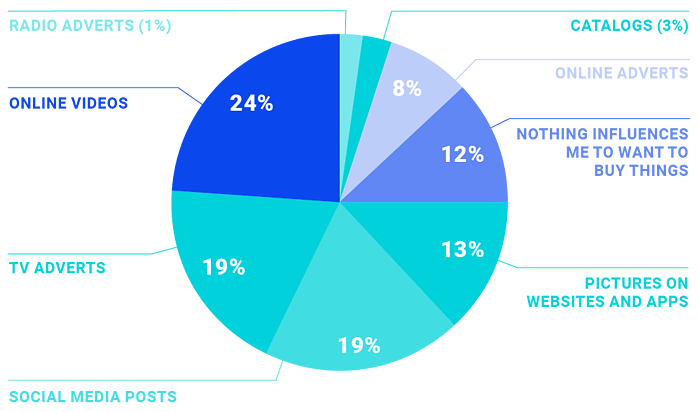The amount of money spent advertising to kids has been steadily rising in recent years, with digital channels take an increasing role. Among those digital channels is social media – and a recent study [download page] of more than 4,000 kids between the ages of 6-16-years-old by Wunderman Thompson has shown that influencers are making their mark with kids.
Not surprisingly, peers are the biggest influencers for kids, with about 3 in 10 (28%) of respondents saying that their friends are the most influential when deciding what they’d like to buy. Family members also have a say as the top influence on buying decisions for 21% share of respondents – but somewhat remarkably they fall behind influencers.
Indeed, one-quarter (25% share) of the kids surveyed say their preference for what to buy is influenced most by influencers or bloggers on social media channels such as Instagram, YouTube and Snapchat.
Younger consumers such as US teens (ages 12-17 years old) are spending more time on YouTube than cable TV, and likely getting a dose of influencer-suggested purchases. But it’s worthwhile bearing in mind the regulatory landscape that limits digital advertising options. For example, Bloomberg recently reported that YouTube will cease offering targeted ad options, after being informed that this might conflict with the Children’s Online Privacy Act (COPPA).
Indeed, it’s not only teens who are being influenced by online marketing. One-quarter (25%) of the youngest survey respondents (6-9-year-olds) and 26% of 10-12-year-olds say that social media influencers have sway over what they would like to buy.
Another factor that has an influence on the majority (66%) of the kids surveyed, is what good the company does for the world.
Corporate social responsibility appears to be a growing theme with the younger generation. Millennials also say their relationship with a company can be deepened if they know that company’s products have a positive impact on society or the environment.
Which Future Shopping Experiences Appeal?
The survey asked kids to indicate which of a number of future shopping methods they would most like to use in 10-20 years’ time. Although about 1 in 10 (11% share) of respondents would most like to be able to shop with their minds in the future, more already established shopping methods are likely to remain prevalent for the foreseeable future. About 1 in 5 (21% share of) respondents say they would like to shop with a mobile/tablet or computer screen, while 19% would still opt for a physical shop. Others say they would most like to shop through a voice assistant (9% share), AR or VR (8%), through the TV (6% share) or with machines that will order things automatically (6% share).
Although this age group appears heavily influenced by social media, only 5% say they would most like to shop through it.
The full report can be downloaded here.
About the Data: A total of 4,003 children (ages 6-16 years old) were interviewed online during July 2019. Half of the respondents were from the US with the other half being from the UK.
Today’s children are different from the generations that have gone before. They’ve grown up with streaming, social media and screens on every available device. This has had a massive impact on how they live – and how they shop. But are retailers prepared for the needs of Generation Alpha?
PREPARING FOR THE FUTURE CONSUMER…
Many organisations are struggling to initiate strategies that will make them relevant for Gen Alphas (aged 6-16) – the future generation of customers. And all the while, retail innovators like Amazon are setting the benchmark for their expectations.
GENERATION ALPHA:
WHAT REALLY MATTERS!
When asked what’s most important in life, they list:

THEY HOLD STRONG VALUES & PRINCIPLES
So be ready to embrace them, treating them as human beings, not just consumers.
- 66% like to buy from companies trying to do good in the world
- 63% would like to work somewhere helping to save the planet
- 59% would like to work somewhere helping to save lives
- 51% want a job where technology makes a difference
UNDER THE INFLUENCE!
55% of Gen Alpha say they’d want to buy a product if their favourite YouTube or Instagram star was wearing/using it.
But friends rule! They outrank social media influencers and bloggers for most influence…
- 28% say friends influence them most on what to buy
- 25% say social media influencers/bloggers influence them most
- 21% say family members influence them most
- 2% say store assistants influence them most
DIGITALLY NATIVE DOES NOT MEAN
DIGITAL ONLY
Think omnichannel! And don’t think there’s any getting away from Amazon any time soon…
- 75% like the experience of going to a physical store
- 9/10 aged 10-16 have heard of Amazon more than Apple & Nike
- 72% of our Gen Alpha survey like Amazon
- 70% even know about Amazon Prime
WHERE DO GEN ALPHA SHOP TODAY WITH THEIR PARENTS?
- 29% in a supermarket
- 26% on Amazon
- 13% on the high street
- 11% on a website other than Amazon
CROSSED WIRES OR
CROSS-CHANNEL CONTENT?
1 in 5 is influenced by online video; but there’s an interesting gender split (check the full report)
Social is key, with 57% inspired to purchase by social media ads…

OTHER AREAS ON THE RADAR
- DELIVERY EXPECTATIONS: 2.23 days is how long Gen Alpha are content to wait for online order deliveries. It’s way less than 2.95 days for adults. Nearly half of children will share photos of their delivered order, too!
- THE ROLE OF ONLINE INFLUENCERS: Native online influencers score more highly than heads of the biggest brands, retailers and marketplaces. Sorry Mr. Bezos and Mr. Cook, but you’re behind Joe Sugg.
- TYPE OF CONTENT HAS AN IMPACT ON INFLUENCE: Online videos (24%) came top, followed by social media posts (19%) and TV ads (19%).
- AMAZON MON AMOUR? Amazon has been conditioning whole new swathes of customers to use its services. We examine how it’s set to influence future expectations.
- TECHNOLOGIES OF TOMORROW’S SHOPPERS: Nearly a quarter of kids have already purchased via a voice assistant. Find out how they want to shop in the years to come.
This article originally appeared in MarketingCharts and is supplemented by data from Wunderman Thompson research. Photo by Kelly Sikkema on Unsplash.













